Aggro Token Druid is an archetype that has evolved dramatically over the course of Hearthstone’s lifespan. Its origin stems from the days of Violet Teachers paired with the Force of Nature + Savage Roar combo that, to this day, haunts veteran players.
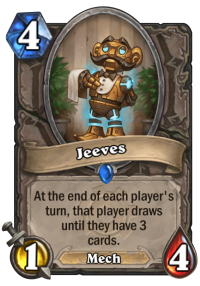
Instead of the midrange take that Combo Druid focused on, most Token Druids have shifted to a more aggressive approach. Power of the Wild offers flexibility to create a minion in times of need or buff a board full of tokens into a frightening pile of stats. The addition of Mark of the Lotus, however, vaulted the deck from viable to top-tier by providing a second, more cost-efficient AoE minion buff.
In Wild, Aggro Token Druid has a couple of unique (and well-mannered) tools that make it a perennial powerhouse in the format. First and foremost, Jeeves allows Token Druid players to confidently dump their hand in the first three turns, knowing they have a powerful hand-refill mechanic in their deck to continue churning out threats. A staple in Wild Aggro decks, Sir Finley Mrrgglton provides the opportunity to find a more valuable matchup-specific hero power with only a few potential downgrades.
More recently, Journey to Un’Goro provided Living Mana giving the Aggro Token Druid the ability to reload the board after clears, which were devastating to the deck in the past.
Update – Wild Aggro Token Druid August 2017, Season 41
Not many changes to most decks right now. With Knights of the Frozen Throne on the way we’re just waiting to see how decks shape up when it’s released.
Wild Aggro Token Druid Variants
The power-level of Mark of the Lotus enabled several variations on the original Token Druid archetype. three common archetypes are found below, each of which builds around the same shell of low-cost, token generating minions and powerful buff cards.
Aggro Egg Token Druid
A consistent presence in the Wild Format, Egg Druid is the most popular variation of the Aggro Token Druid archetype and will be the exemplar of this article. True to its name, the deck leverages its buffs to generate additional minions from both Dragon Egg and Nerubian Egg in addition to the sticky minions present in all versions.
Egg Druid lists have evolved over time, adjusting to the refinement of the Wild metagame. Including Innervates allows the deck to consistently outpace other aggressive decks. Swapping in Living Mana gives the deck both a response to board clears and a catch up mechanic, in favor of the more proactive (but conditional) solution of Soul of the Forest.
Aggro Beast Token Druid
Perhaps a bit of overflow from Standard, Aggro Beast Token Druids have become increasingly popular on the Wild Ladder. Efficient Beasts such as Haunted Creeper and Enchanted Raven offer ideal targets for Mark of Y'Shaarj and an Innervated Vicious Fledgling on turn one can win the game by itself.
The power of the list was showcased in the Wild Open by champion Alb787, who piloted a well-optimized version of the Beast Variant on his path victory.
Aggro Murloc Token Druid
Murlocs have always had great snowballing potential and when combined with the buff cards available to Druid (and, of course, Innervate), the results are pretty outrageous. Here, Adapts from Gentle Megasaur, which replaces Living Mana and/or Soul of the Forest, gives the option to pile on aggression can leave the deck slightly more susceptible to board wipes.
Finja, the Flying Star offers massive board swings, including the possibility of pulling Old Murk-Eye for surprise finishes.
Tony Banger developed and optimized the list, finishing Season 39 at Rank 2 EU, proving the viability of a Murloc build.
(Author’s Note: I took the same list to a brief stint as Rank 1 NA in Season 40, managing a ridiculous turn three lethal along the way.)
Wild Aggro Token Druid Mulligan Strategy & Guide
The mulligan section will be divided into two parts: against fast decks and against slow decks. Fast decks are generally Aggro decks (e.g. Pirate Warrior) or high tempo Midrange decks (e.g. Midrange Hunter). Slow decks are slower Midrange and Control decks.
The variety of archetypes for each class in Wild makes the mulligan phase a bit of a challenge. If you’re unsure about what deck your opponent is playing, operate under the assumption that it’s the fastest variant for the class. You can always draw into the cards you need against slower decks. Contrarily, if you mulligan for the slow variant, you’re likely to end up dead very quickly if you’ve guessed wrong.
VS FAST DECKS
Higher Priority (Keep every time)
- Innervate: There is no point in having Innervate in your deck if you don’t intend to keep it in your opening hand. Against fast decks, this gives you a head start on the board, ensuring that you can get ahead early and, ideally, stay ahead. You don’t want two of these in hand, though.
- Bloodsail Corsair: Corsair is devastating against weapon classes that trade face damage for board presence, but his ability to pull Patches the Pirate from your deck makes him a valuable early turn play in any matchup by providing an additional buff target.
- Fire Fly: A new addition to the deck, Fire Fly offers a decent turn one play while replacing itself in hand. The Flame Elemental it generates is useful in filling out your curve and creating more flexible turns.
- Mark of the Lotus: The slew of cheap minions in this deck create numerous bodies to for Mark of the Lotus to buff. Getting this card out early in the game cements your board position against other fast decks and enables your Eggs.
Lower Priority (Keep only if certain conditions are met)
- Sir Finley Mrrgglton: A one drop minion with high health, Sir Finley isn’t a bad turn one play but you would rather have more information about what deck your opponent is playing before committing to a new Hero Power.
- Dragon Egg: On the cusp of being a High Priority keep, Dragon Egg pairs well with Mark of the Wild against aggressive decks to slow aggression and generate tokens. On its own, however, it does very little to challenge board position against fast decks.
- Living Roots: When paired with Mark of the Lotus, Roots can give you an early advantage, but you usually want a little more out of your turn one play than something that will die to Maelstrom Portal or Rusty Hook.
- Mark of the Wild: With the right minion in play, Mark of the Wild will put a halt to an opponent’s early aggression long enough to claim board advantage. However, its conditional nature makes it a lower priority than other cards in the mulligan.
- Haunted Creeper: Against aggressive decks, Haunted Creeper can chip away at opposing minions and generate additional tokens to receive buffs making it a decent turn two play. That said, passing on turn one feels pretty bad for any aggressive deck, so only keep it in hand with The Coin or a viable turn one play.
VS SLOW DECKS
Higher Priority (Keep every time)
- Innervate: Again, this gives your deck a speed boost, while less necessary against slower decks, may be able to give you the explosive start required to finish the game before the opponent can stabilize.
- Bloodsail Corsair: Corsair can be used to reduce removal options against weapon classes, but pulling Patches the Pirate means that it generates a charging token for buff turns. It also makes it impossible to draw patches in later turns, which can be crippling against slower decks.
- Fire Fly: Frequently, you best play on turn one. The additional minion that it generates can be used to fill out your curve in future turns, which is very relevant in a deck that relies so heavily on strong plays in the first few turns of the game.
- Mark of the Lotus: Your most efficient buff spell, Mark of the Lotus with token generators in hand can be game winning.
- Dragon Egg: Against slower decks, you want your early board to be resilient to board wipes and Dragon Egg provides exactly that against damage-based board clears.
Lower Priority (Keep only if certain conditions are met)
- Haunted Creeper: Creeper is only considered a Low Priority because you really want a turn 1 play. The ghost spider’s resilience to AoE makes it a great turn 2 play against slower decks.
- Living Roots: Again, you want to save this card to be played with buff spells, but it can be an important part of an aggressive opener against some slow matchups.
- Nerubian Egg: Like Haunted Creeper, the second Egg in the deck builds a resilient board but doesn’t put out much aggression on its own. The card should be timed around the available AoE’s for your opponent and is better in the early game in some matchups.
Wild Aggro Token Druid Play Strategy
Aggressive decks, such as Token Druid, are often miscategorized as easy to play. The reality is that, while the low skill floor is somewhat forgiving, playing an Aggro deck optimally requires several difficult decisions throughout the course of the game.
Aggro Token Druid is no different. Often, simply playing out your curve can put you in a losing position and the deck can draw awkward hands that require you to think through your options and map out several turns in advance.
Vs Aggro
One of Aggro Token Druid’s strengths, regardless of the variant, is its ability to out-pace other aggressive decks. The numerous token generators and low-cost buff spells are crucial to this game plan. Bring Innervate into the mix and the decks can shoot out of the gate.
However, losing control of the board is a recipe for disaster in any matchup. Make efficient, value trades in the early turns (utilizing your buffs if you need to) until you are in a strong enough position to take advantage of AoE buffs and/or finish the game with Savage Roar.
Vs Control
In Control matchups, an explosive start can win you the game in a few turns. Most Control decks, however, have responses to your early game pressure so, while possible, sprinting to the finish line may play directly into their hand.
Be aware of the removal options your opponent has available (especially AoE) and avoid overextending into it. Time your Eggs around their mass removal so, even if they clear, you retain initiative on board. Try to test for and/or bait out AoE spells around turn four with Living Mana in hand, which gives you an immediate board refill response.
Wild Aggro Token Druid Matchups and Winrates
Due to the wide variety of decks in the Wild format, only those that are considered Tier 2 and above are considered in the matchups. The best-performing deck for each class will be included, regardless of tier.
*Win rates for archetype matchups are calculated using data from last month minimum of 50 games played vs each archetype and are provided by Metastats.net
Druid
Jade Druid: 56%
Originally a deck that was highly susceptible to early game pressure, Jade Druid has found a way to include more answers to aggressive decks. In Wild, the availability of Sludge Belcher can be tough for the Aggro Token Druid, but the matchup is still slightly favored if you can get far enough ahead in the early game.
Be aware of the threat of Primordial Drake and avoid overextending into it too far. Even on six mana, you should be concerned about overextending too far into an Innervated Drake.
Hunter
Midrange Hunter: 50%
While the stats suggest this is fairly even, it’s more than likely in the Druid’s favor. Hunter does have a slew of early game Beasts that can challenge your early board, but you should be able to outpace their pressure.
If Secrets are in place, test for as many as you can before blinding attacking the face and losing your board to Explosive Trap. Unleash the Hounds plus Scavenging Hyena on turn five is a bit scary, but you shouldn’t deviate too far from your game plan to avoid it.
Mage
Secret Mage: 55%
A wide board is a nightmare for Secret Mage and, fortunately, Aggro Token Druid builds exactly that. Apply as much pressure as your can in the early turns and avoid killing their good Duplicate targets when you can.
Counterspell is a hindrance at times since it trades for your buff spells at times. That said, it can be a three mana investment into your one mana spell. If you can, test for with Living Roots or either Mark before going in for the kill with Savage Roar.
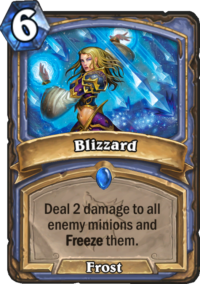
Reno Mage: 54%
Sticky minions are the path to victory against Reno Mage. Cards like Haunted Creeper, Dragon Egg, and Nerubian Egg hold up well to board clears against the numerous AoE spells available to the Mage.
Eventually, you’ll want to finish the game with either an overwhelmingly high-statted board or a Savage Roar (or both). Ice Block and Reno Jackson can be frustrating, but if you retain your board pressure, you have the potential to kill the Mage as many times as it takes.
Freeze Mage: 55%
Similar to the Reno Mage matchup, sticky minions help against the AoE damage spells. Doomsayer, however, makes Dragon Egg a little less relevant and you can often get stuck with a board full of frozen minions. Extend more freely once you have seen both Doomsayer and hold both Nerubian Egg and Living Mana as a direct response to the card if you can.
Paladin
Midrange Paladin: 52%
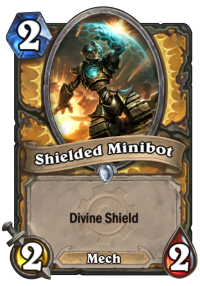 The new powerhouse in the Wild Meta, Midrange Paladin can be a problem for the Aggro Token Druid, but the matchup is certainly winnable. Their ability to generate enough tokens to counter-pressure your early game coupled with a much more valuable late game leaves you with a short window to finish the game.
The new powerhouse in the Wild Meta, Midrange Paladin can be a problem for the Aggro Token Druid, but the matchup is certainly winnable. Their ability to generate enough tokens to counter-pressure your early game coupled with a much more valuable late game leaves you with a short window to finish the game.
Board clears, such as Equality and Consecration, and frustrating Taunt minions make it difficult to close out games before the Paladin takes control. An aggressive start and a contingency plan for board clears should be your primary focus.
Secret Paladin: 47%
Similar to the Midrange Variants, Secret Paladin is a challenge for this deck. Shielded Minibot curving into Muster for Battle is difficult for Aggro Token Druid to manage. If you throw a turn one play into the mix, as both decks often do, the Druid can feel helpless at times.
While Secret Paladin runs fewer board wipes, it does often include several taunt minions that your deck has no way through. Outpacing their early game is once again the key to victory.
Priest
Combo Priest: 48%
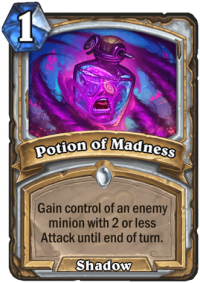 Combo Priest has a set of strong early game minions that can be a challenge for the Aggro Token Druid to remove. Deathlord, especially, puts up a massive roadblock and the downside of the Deathrattle presents little concern for the Priest due to the sheer number of low-cost minions in your deck.
Combo Priest has a set of strong early game minions that can be a challenge for the Aggro Token Druid to remove. Deathlord, especially, puts up a massive roadblock and the downside of the Deathrattle presents little concern for the Priest due to the sheer number of low-cost minions in your deck.
An explosive start is really your best chance here. Getting buffs out early on a wide board can overwhelm the priest who lacks much in the way of recovery. Be aware of Potion of Madness trading two for one (and permanently stealing tokens) and remember that any minion on the Priest’s side can quickly turn into a massive threat.
Dragon Priest: 52%
Like Combo Priest, Dragon Priest plays a steady curve of well-statted minions in the early game and, despite the cited Metastats, can be problematic from the Aggro Token Druid’s perspective.
A good early start is once again important so that you’re able to overrun the high health minions that the Priest puts in play. Again, Potion of Madness is a concern, but AoE spells come out late (if at all) so your primary concern is keeping up board pressure to deal with the early minions.
Rogue
Miracle Rogue: 58%
Aside from Fan of Knives, which is of little concern, Miracle Rogue has few answers to the wide board that Aggro Token Druid hopes to generate. With that in mind, you’re able to freely commit your minions to the board in most situations, inevitably leading to a board of cheap minions overrunning your opponent.
Do not, however, commit too many resources into a single minion, since the Rogue does have options for single-target removal in the form of Sap, Eviscerate, and Vilespine Slayer.
Shaman
Control Shaman: 43%
Easily the worst matchup for the deck, everything Control Shaman does absolutely wrecks the Aggro Token Druid’s game plan. Early game AoE spells answer the wide board and, even if you buff minions out of range, Devolve cuts them back down to size (not to mention what it does to Living Mana…).
Even if you somehow manage to dodge their board clears, massive taunt minions and three mana heals are enough to pull them out range of Savage Roar finishing turns. Essentially, you’re often stuck playing out your typical game plan hoping their hand is full of cards too expensive to play before you score a kill.
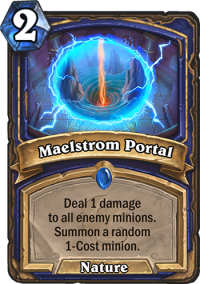
Aggro Shaman: 49%
Aggro Shaman is one of the few aggressive decks Aggro Token Druid doesn’t want to run into. While outpacing their early game isn’t usually a problem, they can halt your pressure through cards like Devolve, Maelstrom Portal, and Feral Spirit.
Quite frankly, the Shaman is just better at reclaiming the board than you are and if you lose the board, you’re likely to lose the game. As such, you need to gain and maintain the board at nearly any cost. Do not commit too many resources into your minions if you get a read there is a Devolve in hand.
Token Shaman: 49%
Token Shaman is a matchup that plays out very similarly to the Aggro Shaman but, thanks to their ability to generate their own token minions and drop a string of taunt minions, the Token Shaman is looking to grind away at your board before turning on the pressure with Bloodlust.
In reality, this is just a slower version of your game plan, so use that to your advantage by seeking a fast start. Bloodsail Corsair into a Jade Claws can be devastating to their early turns. If you can dodge both copies of Devolve, you may be able to build up your tokens maintain board pressure long enough to close the game with Savage Roar.
Warlock
Reno Warlock: 50%
A fairly even matchup, Reno Warlock often comes down to whether or not the Warlock draws Reno Jackson in time. Greedy variants may not have enough early game tools to handle your aggression, so even if Reno comes down on turn six, you may have a powerful enough board to keep the pressure going post-Reno.
Reno Warlock has access to early game AoE in the form of Demonwrath and Hellfire, so try to get sticky token generators down in the early game and build up your board around them.
Warrior
Pirate Warrior: 56%
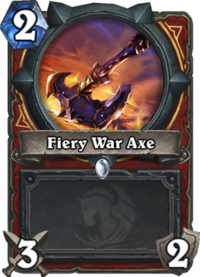 The abundance of Pirate Warrior on the Wild Ladder is, at least in part, keeping Aggro Token Druid in a good position in the meta. Hold Bloodsail Corsair to take down the final charge of Fiery War Axe and make value trades in the early game to limit the amount of synergy the Warrior can take advantage of before turning up the pressure against the Warrior around turn four.
The abundance of Pirate Warrior on the Wild Ladder is, at least in part, keeping Aggro Token Druid in a good position in the meta. Hold Bloodsail Corsair to take down the final charge of Fiery War Axe and make value trades in the early game to limit the amount of synergy the Warrior can take advantage of before turning up the pressure against the Warrior around turn four.
If your deck runs Golakka Crawler, you have more than enough tools to punish the most popular deck in the format.
Control Warrior: 46%
Both Traditional and Taunt Control Warrior have enough tools to stifle the aggression of Aggro Token Druid, making it a difficult matchup. Like the control variants of Mage, you want to prioritize board resilience going into to Brawl turns. Avoid keeping your minions on one health since Whirlwind effects, a liability with Dragon Egg in play, can destroy the remnants of your value trades.
Savage Roar can finish the game after a fast start and should be your primary goal. Having Living Mana in hand allows you to more freely dump your minions into play.
Wild Aggro Token Druid Card Substitutions
Overall, Aggro Token Druid has a fairly reasonable crafting cost, but there are some small changes that can be made to make it even more budget-friendly. Additionally, there are a handful of flex spots in the deck that can be used to rotate tech cards into.
Of the two Legendary cards, Patches the Pirate is the most necessary card due to his token generation and justification for the inclusion of Bloodsail Corsair. As such, there is no direct replacement for Patches in this deck (or most others he’s included in).
Like Patches, Jeeves is a requirement for any variant of the deck to function. His ability to refill your hand after dumping your inexpensive cards in the first few turns cannot be matched.
Basic
- Innervate: Depending on the matchups you’re expecting, Innervate may be a card worth rotating out of the deck. It provides explosive openers against aggro decks but is a dead draw in matches that require a little more out of your late game. Including cards such as Golakka Crawler, Mark of Y'Shaarj, and Defender of Argus hedge a little better against a wide range of matchups.
- Mark of the Wild: In the baseline Egg variant, Mark of the Wild is often valuable due to its ability to force awkward trades into your Eggs. However, depending on the number of beasts that make their way into your deck, Mark of Y'Shaarj may be strictly better than Mark of the Wild.
Rare
- Dragon Egg: As seen in the success of different variants of Aggro Token Druid, the Eggs are powerful, but not critical to the archetype’s success. Replacing them may shift the deck to the Beast-focused version, but Enchanted Raven is a reasonable direct substitution.
- Nerubian Egg: Your second Egg can make opponents hesitate before clearing the board you’ve built, but offers little in the way of pressure against aggressive decks. As a result, Nerubian Egg can be replaced with Golakka Crawler to improve matchups against the numerous decks that include pirates.
Epic
- Echoing Ooze: Ooze is the best target for your Mark of the Wild, but can be replaced with other sticky and/or high value minions such as Enchanted Raven, Argent Squire, or Golakka Crawler.
- Living Mana: It’s ability to provide a reactive board refill makes Living Mana a powerful card in the deck. It can, however, be replaced by Soul of the Forest, a card that was used in this spot before the release of Journey to Un’goro and offers a more proactive solution to board clears.
Legendary
- Sir Finley Mrrgglton: In Aggro Token Druid, you really want to find a better Hero Power than what you start with. Sir Finley provides you with several better options that can improve your winrate but can be replaced with cards that have been squeezed out of the deck due to lack of space. Defender of Argus, Golakka Crawler, and Enchanted Raven are all viable options.
About the Author
A card game veteran, Roffle has been infatuated with Hearthstone since closed beta. These days, he spends most of his time climbing the Wild legend ladder. Roffle has a wealth of experience in Wild Hearthstone, consistently maintaining high ranks on ladder since the format’s inception along with a top 16 finish in the inaugural Wild Open Tournament. Follow him on Twitter or catch him on Twitch for an occasional stream.
















/rating_1_half.png)
/rating_2_off.png)
Hi! I dont have the Echo ooze, what Can i play instead of that? Druid of the swarm?
Yes, Druid of the Swarm is a good replacement. That said, this deck is a little outdated. I would look at something closer to this:
http://www.hearthstonetopdecks.com/decks/sipwis-1-legend-wild-aggro-token-druid-kobolds-catacombs/
after the nerf this deck is unplayable: 7 lose 0 wins
The deck is not quite as strong, but certainly capable post nerf. It should, should remove Innervate in favor of Druid of the Swarm. I’ve been running something similar with a positive win rate at Legend ranks.
Is it still playable after innervate nerf ?
Or what should i use instead of innervate
Yeah, it’s still powerful despite the change to Innervate. I’m testing specific cards/tech choices right now to update this, but subbing Innervate for Druid of the Swarm is a solid baseline list.
Great guide and thaks for sharing! But please change the name of the deck, this isnt “Token Druid” this is “Egg Druid” and its totally different from wild token D.. Greetings!
Thank you! And your feedback is appreciated. As you mentioned, the guide does outline Egg Druid deck specifically, but the deck (along with those referenced in the Variants section) all fall under the same archetype of Token Druid.
The variants of Token Druid play so similarly, it didn’t seem necessary to write a guide for each but it’s something I’d be open to in the future if there is demand for it.